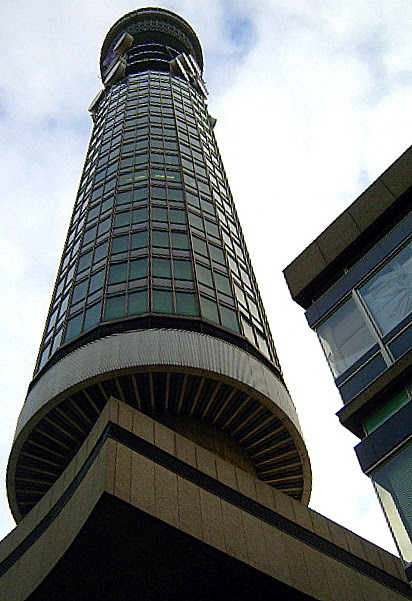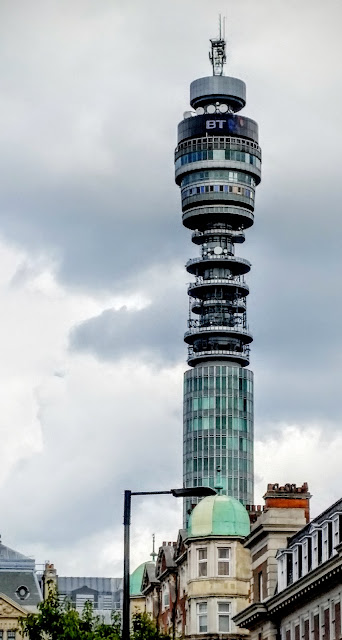 |
| British Telecom Tower (GPO Tower, Post Office Tower), 2010 |
I have always been fascinated with the BT Tower, ever since I first saw it. I am not sure what it is about the building, once the tallest in London, but it just looks cool to me. Maybe it is its uniqueness that makes it so fascinating.
 |
| The view from below, 2010. |
Also, considering how visible it is, it took me an age to get close to it. I would walk towards it and often find that I had passed it, or ended up walking down the wrong road and missing it again. In 2010 I made a conscious effort to finally get a decent photo of this historic tower... and I did.
Brief History
In 1961 construction work on the tower began. The building was required to replace the old steel tower, atop the Museum telephone exchange, as taller buildings that were in the planning stage would have interfered with the 'line of sight' of radio and televisions signals.
The tower. comprised of glass clad concrete, was completed in 1964 and officially opened by Prime Minister Harold Wilson on October 8, 1965. On May 17, 1966 HM Queen Elizabeth II visited the tower, before its opening to the public on May 19, by Postmaster General Tony Benn and Billy Butlin.
 |
| The BT Tower from the Post Building Roof Garden. |
The restaurant served over 100,000 diners in its first year of operation, while the Tower saw just shy of one million visitors.
On October 31, 1971 a bomb exploded on the roof of the toilets at the top of the tower, resulting in damage to the restaurant and buildings and cars up to 400 yards away. The restaurant was closed to the public later that year and never reopened to the public. Butlin's lease on the restaurant expired in 1980, with public access to the building ending in 1981.
 |
| Reflection of the BT Tower. |
Following many renovations that have included the installation of subterranean optical fibre links and a massive 360° coloured lighting projection system. The original display, installed in the early 2000s, was programmed with seven colours and intended to appear as a rotating globe. In 2009, a 360° full-colour LED-based display system was installed at the top of the tower and was the largest of its type in the world.
 |
| The LED-based display system. |
In 2011 some of the defunct antennae were removed as they were in a bad state of repair. The last of which was removed in December 2011. The removal of these antennae allows the core of the tower to be visible.
 |
| The Core. |
The Tower is still in use and is used for various corporate and charitable events.
Specifications
The BT Tower main structure is 177 metres tall, but including the aerial rigging brings this to 189 metres.
The Tower will nove a maximum of 25 cm in wind speeds of up to 95 mph.
The first 16 floors were originally for power and technical equipment.
Above this is the 35 metre section for the aerials.
Above this are 6 floors of suites, kitchens, more technical equipment and a revolving restaurant.
The revolving restaurant was called 'Top of the Tower' and completed a revolution every 23 minutes.
Two high speed lifts can reach the top of the tower in less than 30 seconds.
In the late 1960s various people competed in 'Races Up the Tower', where they raced to the top of the tower by using the stairs. The fastest recorded time was 4 minutes 46 seconds.
Between 1964 and 1980 it was the tallest building in London, replacing the Millbank Tower and being surpassed by the Natwest Tower.
thanks for sharing this info with us!
ReplyDeleteYou are most welcome.
Delete